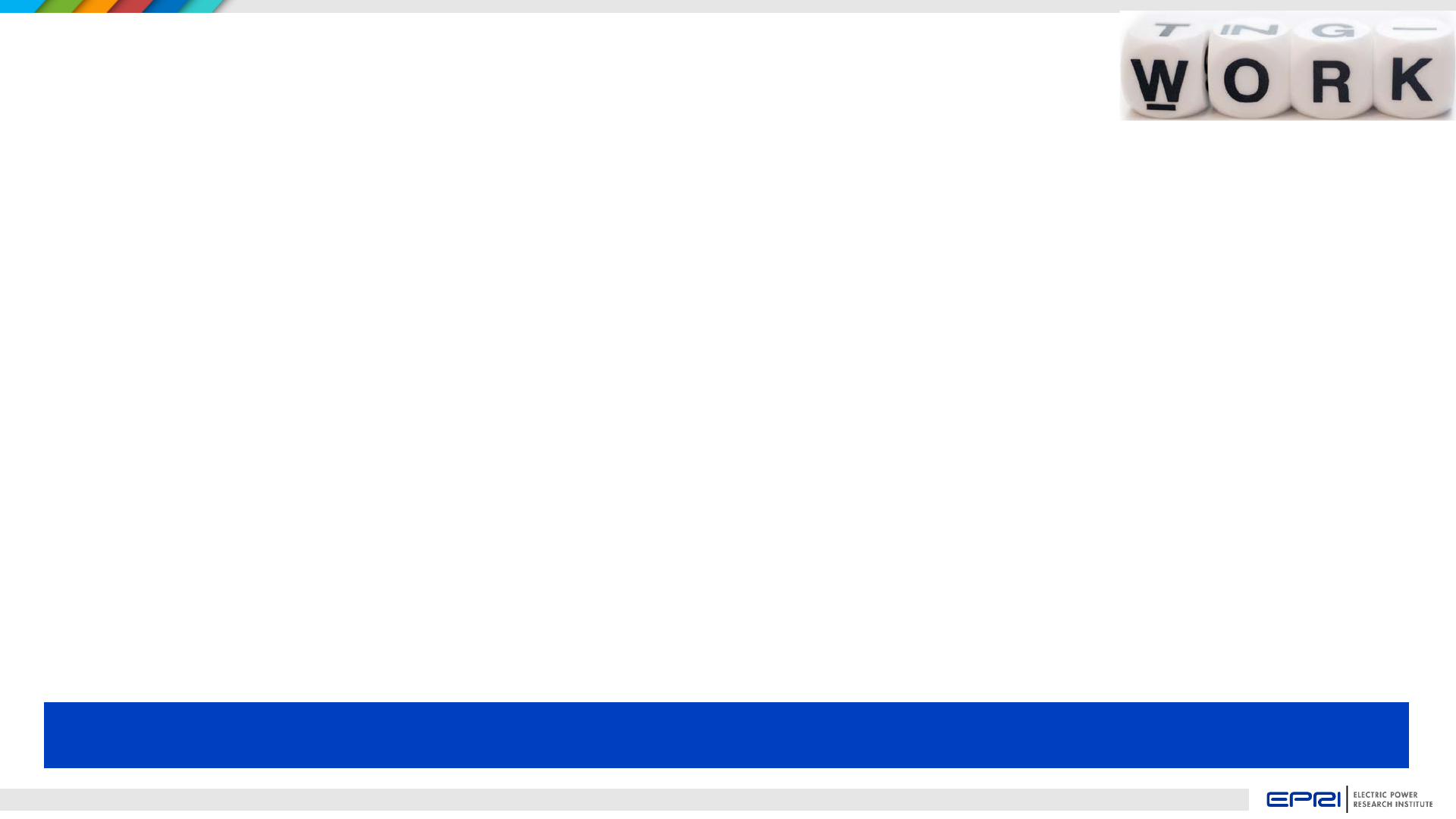
© 2019 Electric Power Research Institute, Inc. All rights reserved.
www.epri.com
Horst Hack
Technical Leader, Principal
2019 NETL Annual Project Review Meeting
for Crosscutting Research
April 9, 2019
Evaluation of Steam Cycle
Upgrades to Improve the
Competitiveness of
US Coal Power Plants
DOE Contract DE-FE0031535

© 2019 Electric Power Research Institute, Inc. All rights reserved.
www.epri.com
2
Project Description and Objectives
Examine the feasibility of retrofitting advanced materials to
improve heat rate, while minimizing plant modifications
Reduce coal consumption of existing utility fleet by increasing
steam cycle efficiency
Increase steam temperatures to Advanced Ultra-supercritical
(AUSC), or USC conditions – while maintaining original pressure
Employ advanced nickel-based high-temperature materials
– Result of DOE-funded materials R&D
Estimate improved capacity factor, and economic benefit from
higher plant efficiency

© 2019 Electric Power Research Institute, Inc. All rights reserved.
www.epri.com
3
Strategic Alignment with DOE Fossil Energy Objectives
Power Plant Efficiency Improvements – Develop cost-effective,
reliable technologies to improve the efficiency of new and existing
coal-fired power plants.
This project aims to evaluate options for existing plants to
upgrade steam temperature for higher cycle efficiency
– Average efficiency of US coal-fired fleet = 33% HHV
– Efficiency increases to over 41% HHV at 1,350°F steam temperature
– Base cases defined to represent 80% of existing coal-fired fleet

© 2019 Electric Power Research Institute, Inc. All rights reserved.
www.epri.com
5
Project Status
Worked with utility partner (Southern Company) to validate
representative subcritical and supercritical base case models
Developed thermodynamic performance models for the upgrade
cases
Evaluated technical feasibility (boiler & turbine) for upgrade cases
– Nine original upgrade cases completed
– Added three new cases
Estimating capital costs associated with feasible upgrade options
Preparing the unit dispatch model – impact on asset profitability

© 2019 Electric Power Research Institute, Inc. All rights reserved.
www.epri.com
6
AUSC Retrofit Study – Work Scope
Model technical feasibility of required modifications
Generate capital cost estimates
GE – boiler and steam turbine
AECOM – balance-of-plant
Estimate the value of the heat rate improvements by detailed
modeling of the unit dispatch in several regional U.S. power
markets (EPRI’s US-REGEN model)
– Compare revenue of upgraded units vs. non-upgraded units
Prepare technical report
Improve heat rate while minimizing power plant modifications

© 2019 Electric Power Research Institute, Inc. All rights reserved.
www.epri.com
7
Project Structure - Tasks
1 Project management and planning
2 Evaluation of technical feasibility
– 2.1 Thermodynamic performance models of base case at full load
– 2.2 Impact of upgrades to base cases at full load
– 2.3 Part load performance for flexible operation scenarios
– 2.4 Dynamic modeling of system for fluid circulation
3 Unit dispatch modeling (EPRI’s US-REGEN model) to 2050
4 Capital cost estimation to AACE Class III (+/-30%)
5 Overall economic evaluation
Two-year project ends in January 2020

© 2019 Electric Power Research Institute, Inc. All rights reserved.
www.epri.com
8
Background – Challenges for AUSC Technology
Greenfield A-USC steam plants may not be cost effective
– Conventional USC (1100°F or 593°C) power plants use lower cost
materials
Retrofits to higher temperature may be more cost effective option
– Significant reuse of existing equipment – decreased capital cost
– Increase only steam temperature – not steam pressure
Limit the scope of equipment replacement
– Superheater and reheater panels
– Steam turbine
– Piping between the superheater/reheater and steam turbine

© 2019 Electric Power Research Institute, Inc. All rights reserved.
www.epri.com
9
Technical Approach - Summary
Maximize the applicability of the study results to existing fleet
– 300+ units with ~2,400 psia (16.6 MPa) main steam (subcritical)
– 100+ unit with ~3,500 psia (24.1 MPa) main steam (supercritical)
Insure that results reflect actual situations in US fleet
– Data from existing operating units supplied by Southern Company
Evaluate a variety of temperature upgrade options
Employ an experienced technical team that has worked together
on prior DOE-funded AUSC project (ComTest)
– EPRI, GE, AECOM, HES

© 2019 Electric Power Research Institute, Inc. All rights reserved.
www.epri.com
10
Technical Approach – Original Upgrade Cases Planned
Case Name Main Steam Pressure
Main Steam
Temperature
Reheat Steam
Temperature
Subcritical Base Case 2400 psi (16.6 MPa) 1000°F (538°C) 1000°F (538°C)
Subcritical USC Option 2400 psi (16.6 MPa) 1100°F (593°C) 1100°F (593°C)
Subcritical A-USC Option 1 2400 psi (16.6 MPa) 1200°F (649°C) 1200°F (649°C)
Subcritical A-USC Option 2 2400 psi (16.6 MPa) 1000°F (538°C) 1350°F (732°C)
Subcritical A-USC Option 3 2400 psi (16.6 MPa) 1350°F (732°C) 1350°F (732°C)
Supercritical Base Case 3500 psi (24.1 MPa) 1000°F (538°C) 1000°F (538°C)
Supercritical USC Option 3500 psi (24.1 MPa) 1100°F (593°C) 1100°F (593°C)
Supercritical A-USC Option 1 3500 psi (24.1 MPa) 1200°F (649°C) 1200°F (649°C)
Supercritical A-USC Option 2 3500 psi (24.1 MPa) 1000°F (538°C) 1350°F (732°C)
Supercritical A-USC Option 3 3500 psi (24.1 MPa) 1350°F (732°C) 1350°F (732°C)
Supercritical A-USC Molten Salt 3500 psi (24.1 MPa) 1350°F (732°C) 1350°F (732°C)

© 2019 Electric Power Research Institute, Inc. All rights reserved.
www.epri.com
11
Base Case Model Development
Base cases were intended to be realistic, based on information
from existing power plants
These are not intended to be identical representations of existing
units
Allowed a more direct comparison, and matching parameters
– Fuel (PRB coal)
– Output (750 MW)
– Steam turbine efficiency (identical)
– Feedwater heater configuration (identical)
– Site location and ambient conditions (Kenosha, Wisconsin)

© 2019 Electric Power Research Institute, Inc. All rights reserved.
www.epri.com
12
Supercritical PC Boiler Base Case Preliminary Sizing
Furnace Roof, Walls, Screen Tubes
Duty 2,650 MMBTU/hr Duty 252 MMBTU/hr
Total Surface Area 75,648 ft^2 Total Surface Area 35790 ft^2
Furnace Width 98 ft Materials
Furnace Depth 49 ft CS 916 tons
Wall Height Below Nose 170 ft
Hopper Height 25 ft Final Superheater
Height Wall Above Nose 21 ft Duty 464 MMBTU/hr
Overall Boiler Height 216 ft Total Surface Area 37810 ft^2
Materials Number Panels 138
CS 1131 tons Panel Width 7.7 ft
Panel Length 18 ft
Division Panels Materials
Duty 346 MMBTU/hr T91 191 tons
Total Surface Area 9962 ft^2
Number Panels 8 Primary Reheater
Panel Width 29 ft Duty 632 MMBTU/hr
Panel Length 16 ft Total Surface Area 54466 ft^2
Materials Number Panels 186
T91 53 tons Panel Width 8.2 ft
Panel Length 18 ft
Platen Superheater Materials
Duty 475 MMBTU/hr CS 68 tons
Total Surface Area 14693 ft^2
Number Panels 113 Economizer
Panel Width 3.2 ft Duty 626 MMBTU/hr
Panel Length 20 ft Total Surface Area 92407.9408 ft^2
Materials Number Panels 253
T91 64 tons Panel Width 10.2 ft
Panel Length 17.5 ft
Finishing Reheater Materials
Duty 509 MMBTU/hr CS 410 tons
Total Surface Area 21085 ft^2
Number Panels 113
Panel Width 4.9 ft
Panel Length 18 ft
Materials
T91 23 tons
ECONOMIZER
FINAL
REHEATER
PLATEN
SUPERHEATER
DIVISION
PANEL
FINAL
SUPERHEATER
PRIMARY REHEATER
COAL
AIR
1
2
3
4 5 6 7
8
9
BFW WATER
COLD REHEAT
MAIN STEAM
HOT REHEAT
10
11
12
13
14
15
16
17
18
19
FURNACE
WATERWALLS

© 2019 Electric Power Research Institute, Inc. All rights reserved.
www.epri.com
13
Model Details for Steam Cases
Nine original upgrade options evaluated using
– EPRI’s PC-Cost for preliminary boiler sizing, and
– AspenPlus
TM
for heat and material balance for boiler and steam cycle
Net power output set to match applicable base case
– Avoid upgrades to the switchyard and transmission lines
Technical feasibility of boiler and steam turbine sections
evaluated

© 2019 Electric Power Research Institute, Inc. All rights reserved.
www.epri.com
14
Model Details for Molten Salt Case
Evaluate molten salt option – goal to reduce costs associated with
nickel alloy steam transfer piping from boiler to steam turbine
Existing main and reheat steam piping will be used to carry 1000°F
(538°C) steam from the superheat and reheat headers down to
the level of the steam turbine.
Separate low pressure molten salt system installed in the furnace
– Extract heat at high temperature (up to 1400°F or 760°C)
– Deliver the molten salt to a heat exchanger at the steam turbine level
where the 1000°F (760°C) superheat and reheat steam flows will be
heated to 1350°F (732°C) before entering the steam turbine.

© 2019 Electric Power Research Institute, Inc. All rights reserved.
www.epri.com
16
Full Load and Part Load Evaluation for Each Case
Evaluate the thermodynamic performance
Calculate the amount of heat transfer surface required
Determine impact upon piping and steam turbine
Model the performance at 75% load and 50% load

© 2019 Electric Power Research Institute, Inc. All rights reserved.
www.epri.com
17
Conclusions from Evaluation of Original Upgrade Cases
Steam cases at 1,100°F / 1,100°F (SH/RH) are feasible for both
subcritical and supercritical configurations
The 1,350°F steam temperature cases are not feasible
– Insufficient space in existing boiler for needed heat exchanger surface
Some 1,200°F steam temperature may be feasible – at least under
some conditions

© 2019 Electric Power Research Institute, Inc. All rights reserved.
www.epri.com
19
Path Forward on Technical Feasibility Evaluations
Expand upgrade options to include three new cases
– Steam case at 1,000°F / 1,200°F (SH/RH) for subcritical
– Steam case at 1,000°F / 1,200°F (SH/RH) for supercritical
– Molten salt case at 1,200°F / 1,200°F (SH/RH)

© 2019 Electric Power Research Institute, Inc. All rights reserved.
www.epri.com
21
A-USC Retrofit Study – Current Status / Work Completed
Completed thermodynamic performance models – two base cases
Upgrade cases have been modeled
– Full-load and part-load evaluations for original steam cases
– Original molten salt upgrade option configuration
– Evaluated technical feasibility of original upgrade options
Calculated sizing of heat exchanger banks
Certain high-temperature options for the supercritical case have
been determined to technically non-feasible
Added three additional upgrade options – being evaluated
Design and performance work done; costs underway

© 2019 Electric Power Research Institute, Inc. All rights reserved.
www.epri.com
22
Market Benefits/Assessment
The average efficiency of the US coal-fired fleet is approximately
33% (HHV)
Capacity factor of existing coal-fired power plants is limited by
efficiency
Steam temperature increases to AUSC conditions, have the
potential to increase efficiency to over 41% (HHV)
This AUSC upgrade path is applicable to 80% of existing fleet
– Technically feasible options could be widely deployed
– Present project intends to quantify potential economic benefits of
increased efficiency (temperature increase to AUSC conditions)

© 2019 Electric Power Research Institute, Inc. All rights reserved.
www.epri.com
23
Technology-to-Market Path
Plant upgrades to USC or AUSC steam temperatures are
compatible with DOE’s goals to achieve power plant efficiency
improvements
Candidate demonstration plants for initial upgrades have been
identified
Primary technology challenges relate to the fabrication of full-
scale AUSC components and supply chain development
– Phase II of DOE-funded ComTest project (DE-FE0025064) addresses these
– ComTest is scheduled to be completed in September 2021

© 2019 Electric Power Research Institute, Inc. All rights reserved.
www.epri.com
24
Conclusions
Upgrades to existing coal-fired plants have the potential to
increase the steam temperature, and cycle efficiency
Maintaining original pressure can minimize plant modifications
Some technically feasible upgrade options have been identified
Capital costs are being calculated for the feasible options
Higher efficiency is expected to lead to increased capacity factor
Unit dispatch models will help to evaluate the potential long-term
return on investment for the plant upgrade

© 2019 Electric Power Research Institute, Inc. All rights reserved.
www.epri.com
25
A-USC Retrofit Study Support Acknowledgement
Acknowledgment: This material is based upon work supported by the Department of Energy under Award
Number DE-FE0031535.
Disclaimer: This report was prepared as an account of work sponsored by an agency of the United States
Government. Neither the United States Government nor any agency thereof, nor any of their employees,
makes any warranty, express or implied, or assumes any legal liability or responsibility for the accuracy,
completeness, or usefulness of any information, apparatus, product, or process disclosed, or represents that
its use would not infringe privately owned rights. Reference herein to any specific commercial product,
process, or service by trade name, trademark, manufacturer, or otherwise does not necessarily constitute or
imply its endorsement, recommendation, or favoring by the United States Government or any agency
thereof. The views and opinions of authors expressed herein do not necessarily state or reflect those of the
United States Government or any agency thereof.





